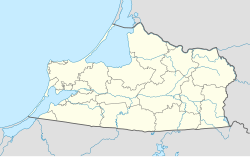Dobrovolsk
| Dobrovolsk (in English) Добровольск (Russian) Pillkallen (1545 – 1938) Schloßberg (1938 – 1947) |
|
|---|---|
| - Inhabited locality - | |
 The memorial complex to soldiers killed in World War II |
|
 Location of Kaliningrad Oblast in Russia |
|
|
|
|
|
|
|
|
|
|
| Administrative status | |
| Country | Russia |
| Federal subject | Kaliningrad Oblast |
| Administrative district | Krasnoznamensky District |
| Statistics | |
| Population (2010 Census) | 1,693 inhabitants |
| Time zone | USZ1 (UTC+02:00) |
| Founded | 1510 (earliest surviving record) |
| Previous names |
Pillkallen (until till 1938), Schloßberg (until 1938 - 1947) |
| Postal code(s) | 238743 |
| on | |
Dobrovolsk (Russian: Добровольск, lit. Voluntary Town ; German: Pillkallen or Schloßberg ; Lithuanian: Pilkalnis ; Polish: Pilkały ), formerly Pillkallen (1510-1938) and Schloßberg (1938-1947) is a village in Krasnoznamensky District of Kaliningrad Oblast, Russia. It has a population of 1,693 (2010).
Historically known as Pillkallen, the village belonged to Prussia since 1701 and the German Empire since the unification of Germany in 1871, and was located in the province of East Prussia until 1945. During the Nazi Germany era it was renamed Schloßberg until the territory was annexed by the Soviet Union following World War II. The village was renamed Dobrovolsk and briefly the administrative center of Pilkalensky District before the district center moved to Krasnoznamensk and reformed into Krasnoznamensky District.
Russian sources give the date of the earliest record of the village as 1510, while the earliest surviving German language record dates from 1516 under the name Schlosbergk, and slightly later the name Mühlenberg is also used. Nevertheless, it is believed that there was already a trading settlement in existence before this. The name Pillkallen first appears in the records in 1545 in connection with an inheritance dispute, and is thought to have originated with Lithuanian settlers, derived from the Lithuanian language term pilkalnis, meaning hill, mound, or castle mound. In 1549 a wooden church was built in the developing market town and a school was established in 1550.
...
Wikipedia


